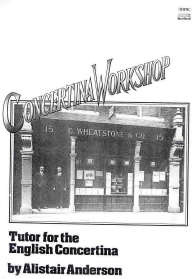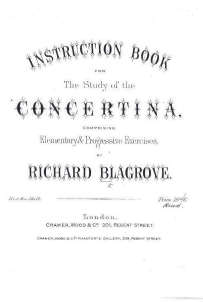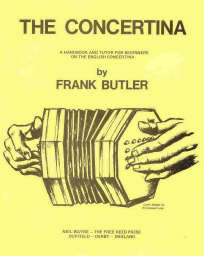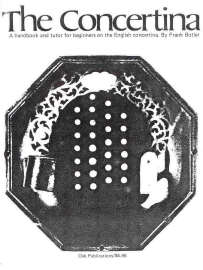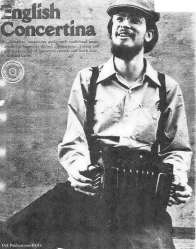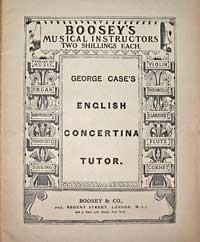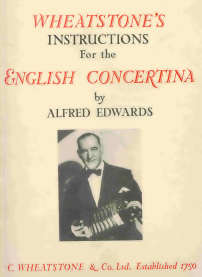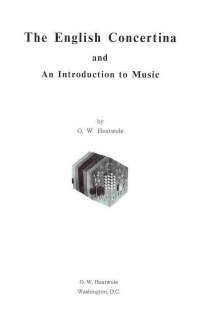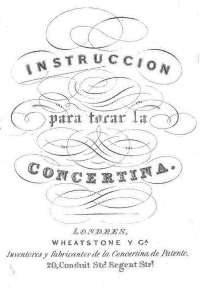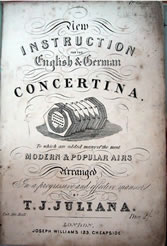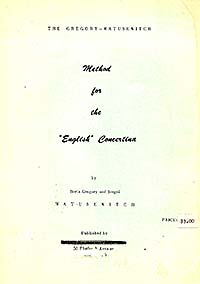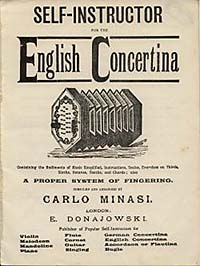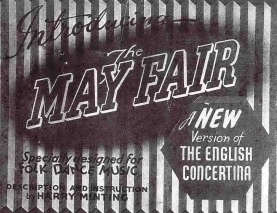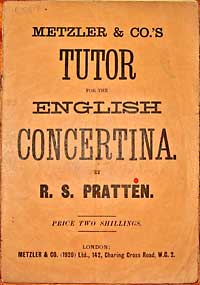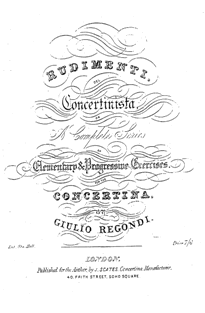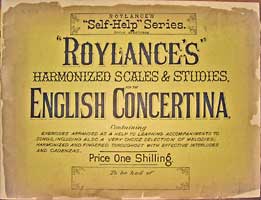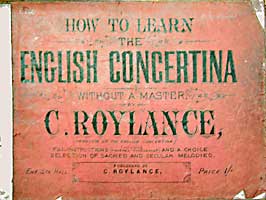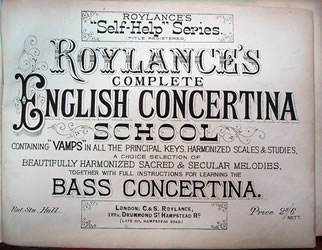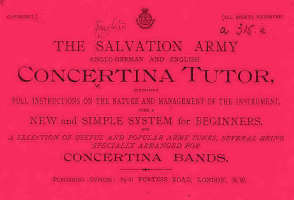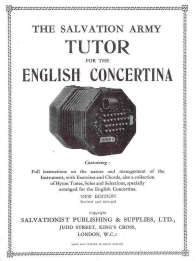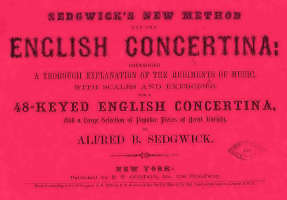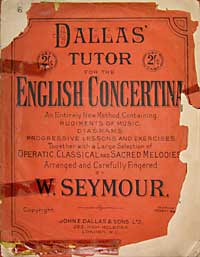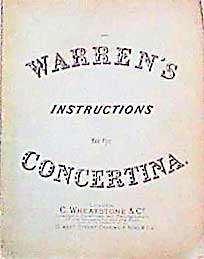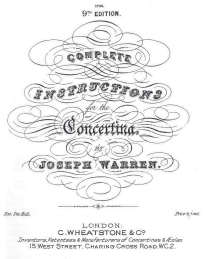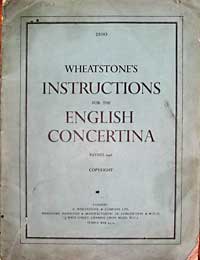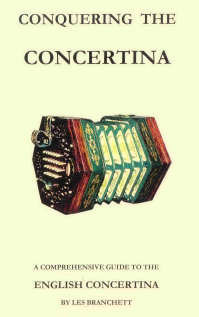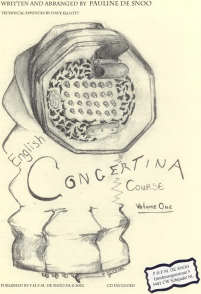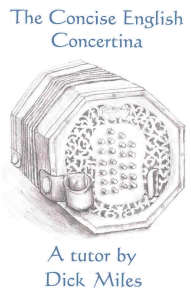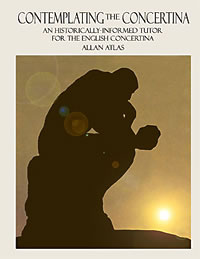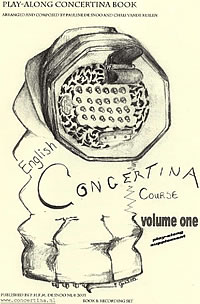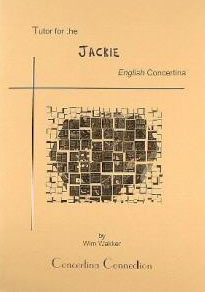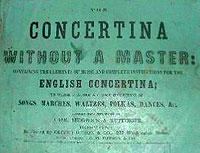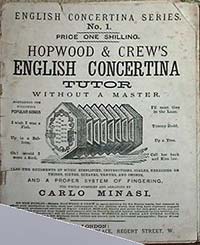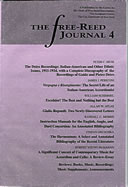Posted 01 April 2003
Instruction Manuals for the English, Anglo, and Duet Concertina:
An Annotated Bibliography
Randall C. Merris
Part I. English Concertina
E1
Alsepti, Signor.
The Modern English Concertina Method. Parts 1-2.
London: Lachenal & Co., c. 1895.
BL, CSFRI, HM
A self-proclaimed pupil of Giulio Regondi (see E51),
‘Signor’ James Alsepti was a well-known concertina performer and
teacher. An 1888 advertisement indicated that he played for parties and dances
and gave daily performances and lessons at
Keith, Prowse & Co. Alsepti was one of the inventors and a major proponent
of “bowing valves”: concertina air valves for
simulating the phrasing of the violin’s bow. In the language of his tutor,
expansion of the bellows is a “down bow,”
compression an “up bow,” and playing successive notes without a change of
bellows direction is playing “in one bow.”
Lachenal & Co., publisher of Alsepti’s tutor, was primarily a manufacturing
firm that made thousands of English, Anglo,
and duet concertinas from about 1850 until it closed in 1935. On the firm of
Louis Lachenal (c. 1821-1861) and his early
association with Wheatstone & Co., see Stephen Chambers, "Louis Lachenal:
Engineer and Concertina Manufacturer, Part
1," The Free-Reed Journal 1 (1999): 7-18. The bowing-valve patent
(“Improvements in Concertinas,” July 8, 1885; Patent
No. 8290) was granted to Alsepti and Richard Ballinger, an employee of Lachenal & Co.
Further on Alsepti, see Allan Atlas, “Signor Alsepti and ‘Regondi's Golden Exercise’,”
Concertina World: International Concertina Association Newsletter
(forthcoming). The Alsepti tutor was also published, somewhat later, by Carl Fischer, New
York.
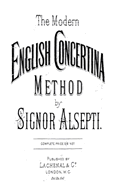
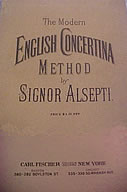
E2
Anderson, Alistair.
Concertina Workshop: Tutor for the English Concertina.
London: Topic, 1974.
AVAIL
Anderson (b. 1948), a leader in the 1960s concertina revival,
is a well-known English concertina performer, teacher, and
recording artist. An LP recording accompanying his Workshop
appears to be no longer available.
E3
Attack, W. J.
New and Improved Tutor for the 48-keyed English Concertina.
London: Morley & Co., 1891.
BL
E4
Birch, William Henry.
A New Tutor for Concertina.
London: Leoni, Lee & Coxhead, 1851.
BL
Birch (1824-1893) was a well-known concertinist, composer, and arranger of music
for concertina and piano. As Atlas noted, he predicted in his tutor that
“The Concertina . . . will ere long become as necessary to the Concert and Drawing
Room, as the Piano Forte” (The Wheatstone English Concertina, 2).
E5
Blagrove, Richard Manning.
Instruction Book for the Study of the Concertina, Comprising
Elementary and Progressive Exercises.
London: Cramer, Wood & Co., 1864 (through the 3rd,
rev. ed., J. B. Cramer & Co., c. 1903).
BL, CSFRI
Blagrove (1826/27-1895) was a major figure among classical concertina
performers and arrangers. He was a member of the
Case-Blagrove-Regondi-Sedgwick quartet (founded in 1844), gave hundreds
of concertina recitals, including one in 1868 at
Windsor Castle at the invitation of Queen Victoria, and actively commissioned
chamber music for the instrument.
Blagrove’s father (also Richard) and brothers, Henry Gamble and William,
were well-known violinists; see Atlas, The
Wheatstone English Concertina, especially Chapters 4-6, and on the family,
The New Grove Dictionary of Music and
Musicians, 2nd ed., ed. Stanley Sadie and John Tyrrell
(London: Macmillan, 2001) 3, 670-671.
E6
Butler, Frank E.
The Concertina: A Handbook and Tutor for Beginners on the English Concertina.
Duffield: Free Reed Press, 1974; New York: Oak Publications, 1976.
BL, HM, LC
Frank Butler (1903-1992)—grandson of concertina-maker George Jones—was
a lifelong English concertina devotee and
promoter of it as performer, author, composer-arranger, teacher,
historian, founding member of the International Concertina
Association, and frequent contributor to concertina newsletters and magazines.
See Alex Richards, “The Frank Butler
Story,” Concertina Magazine 9 (Winter 1984): 20-22. The tutor
contains an excellent
short history and description of
concertina systems, as well as instructional material.
E7
———.
Concertina Two.
London: F. Butler, 1983.
OSS
Alex Richards’s review appears in Concertina Magazine 7 (Summer 1984): 18-19.
Butler’s Arranging Music for the English
Concertina With an Introduction to Harmony, a supplement, appeared soon after
Concertina Two.
BL
E8
Carlin, Richard.
English Concertina.
New York: Oak Publications, 1977 (floppy vinyl record
included).
LC
E9
Case, George Tinkler.
The Baritone Concertina: A New Method,
Containing Introductory
and Explanatory Remarks, Followed by a Selection from the Best Masters.
London: Boosey & Sons, 1857.
BL, CSFRI
Case (1823-1892) was a violinist, pianist, and concertinist
who turned out a voluminous amount of music for the concertina.
He also manufactured concertinas, acquiring his firm from
Joseph Scates in 1850-1851 and selling it to Boosey & Co.
around 1859. On Case and his works, see Atlas, The
Wheatstone English Concertina, especially Chapters 4-5. The Case
concertinas in the Horniman Museum are described in
Neil Wayne, Concertina Book: Final Edit
(unpublished typescript,
1986), 55-58.
E10
———.
Boosey’s Shilling Tutor for the Concertina.
London: Boosey & Sons, c. 1855.
EWER
Contains most of the contents of Case’s Instructions for Performing on the
Concertina ( E13).
E11
———.
Exercises for Wheatstone’s Patent Concertina.
London: Wheatstone & Co., c. 1845.
BL
The exercises were also marketed in two sets:
Exercises for Daily Practice, No.1 (in C) and No. 2 (in G).
E12
———.
George Case’s English Concertina Tutor.
London: Boosey & Co., 1883.
BL, CSFRI, HM
E13
———.
Instructions for Performing on the Concertina.
London: Wheatstone & Co., 1849; London: Boosey & Sons, c. 1854
(and subsequent editions through the enlarged 4th ed., c. 1875).
BL, CSFRI, HM
Case did not view the tutor as a self-instructor: “the Author . . .
does not expect that his course of instruction will supercede
the necessity of a Master . . . His endeavours have been to
cooperate with, and assist the Master” (p. 2). Case concludes with
admonitions about improper demeanor, including: “all contortions
of the face, twisting of the mouth, or the like evidence of
difficulty in expressing abstruse and elaborate passages,
should be scrupulously avoided . . . a continual swaying of the body
(however much it has a tendency to preserve the time)
causes an unpleasant sensation in the spectator . . . [and] a serene and
unconstrained expression of countenance should be as
much as possible preserved” (p. 62). The first edition was advertised
as forthcoming in the Wheatstone & Co.’s,
“Music for the Concertina,” 1848. The fourth edition from Boosey & Co.
(Boosey & Sons before 1864; see Parkinson,
Victorian Music Publishers, 31) has
"Case’s Concertina Tutor" on the cover, but
shows the title as "Instructions for Performing on the Concertina" on the title page.
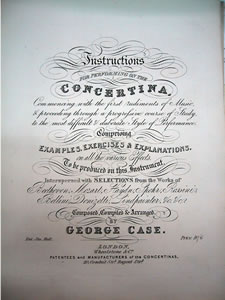
E14
———.
Supplement to the Concertina Instructor No 1.
London: Boosey & Sons, 1855.
BL
E15
———.
Universal Instructions from the First Rudiments
to the Most Elaborate Style of Performance for the Concertina.
London: Boosey & Sons, c. 1855.
EWER
E16
Chesney, Edwin.
New Instructions for the Concertina
with Progressive Exercises. Books 1-2.
London: E. Chesney, 1857.
BL
“It is not generally known that the Concertina is an easy instrument
to learn. . .The beautiful harmony which can be
produced from it, enchants the hearer while its
portability renders it a most convenient little companion” (p. 1).
E17
———.
New Instructions for the Concertina with Upward of One
Hundred Progressive Exercises.
London: E. Chesney, 1852.
BL
E18
Chidley, Edward.
Chidley’s Instructions for the Concertina.
3rd ed. London: R. Chidley, 1854.
BL
Edward Chidley, Sr. (1830-1899) and brother Rock Chidley
(see A14) worked
at Wheatstone & Co. in the 1840s prior to
starting their own concertina-making businesses. Edward
Chidley later returned as a manager of Wheatstone & Co. His
family provided three generations of Wheatstone managers:
Edward, Sr., succeeded by his elder sons, Edward, Jr. (1858-
1941) and Percy (1863-1949), who were succeeded by Edward,
Jr.’s son, Kenneth Vernon (1892-1964). Another of Edward,
Jr.’s sons, Gifford Marcus Chidley (1896-1980), also worked
at Wheatstone & Co. Edward, Sr. also arranged music for
concertina and piano. His name is incorrectly given as Edwin
in the British Library catalogue. See Atlas, The Wheatstone
English Concertina, 4, 40; and Wayne, Concertina Book,
65-67.
E19
Robert Cocks & Co.’s Hand Book of Instructions
for the English Concertina, With 32, 40, and 48 Keys.
London: Robert Cocks & Co., 1855.
BL
One of several tutors that were designed for the early
concertinas that had mean-tone tuning: “The Concertina, besides
having a complete Chromatic scale, has the difference
between the G sharp and A flat, and D sharp and E flat throughout the
instrument, each of which are distinct notes . . . ” (p. 2).
On Wheatstone’s use of mean-tone tuning, see Atlas, The
Wheatstone English Concertina, 40-47.
E20
Robert Cocks & Co.’s Tutor for the Concertina.
London: Robert Cocks & Co., c. 1860.
ADVERT
E21
Davidson, George Henry.
Davidson’s Concertina Tutor.
London: The Music Publishing Company, 1880; J. R. Lafleur & Son, 1885.
BL, HM
Davidson was a prolific author and publisher of tutors,
songbooks, and serialized music collections.
E22
Dobigny, A.
Self-Instructor for the English Concertina.
London: E. Donajowski, c. 1885-1892.
ADVERT
Dobigny was a well-known composer and arranger for
concertina and other instruments. This tutor and his Self-Instructor
for the German Concertina ( A23)
are from “Dobigny’s Popular Self-Instructors” series (1885-1892).
E23
Drouët, Louis-François-Phillippe.
The Elementary Principles of Harmony and Modulation
Indispensably Necessary to be Known by Every Performer on the Concertina, Followed by
the Art of Embellishing a Simple Melody (Adapted to the Concertina by Joseph Warren).
London: Wheatstone & Co., c. 1846.
BL (stamped 1855)
The Dutch-born (of French descent) Drouët (1792-1873)
was one of the most influential nineteenth-century flautists as
performer, composer-arranger, author and teacher, and
designer-maker of flutes (established in England in 1818-1819). The
book is on music theory and, except for the title, is
not specific to the concertina. (On Joseph Warren,
see E68.)
E24
Edwards, Alfred.
Wheatstone’s Instructions for the English Concertina.
London: Wheatstone & Co., 1960.
BL, CSFRI, HM, LC
“Alf” Edwards (c. 1905-1985) was surely the most
successful twentieth-century concertinist in terms of building a career as
a “commercial” musician; he performed frequently
on radio, television, and film scores.
E25
The English Concertina.
London: Hawkes & Son, 1921.
LC
In 1930, Boosey & Co. (founded in the 1760s) merged
with Hawkes & Son (founded in 1865), and the tutor was reissued as
The Simplicity Tutor for English Concertina, rev. ed.,
London: Boosey & Hawkes, c. 1930-1935 (HM and
LC). In 1948,
Boosey & Hawkes acquired Besson & Co., the brass-instrument
manufacturer that had purchased Wheatstone & Co in the
1940s. Boosey & Hawkes sold Wheatstone & Co. to Steve Dickinson in 1975.
E26
English Concertina Instructor.
Boston: Oliver Ditson, c. 1865.
BMTCC
E27
Hamilton, Ernest.
Dallas’ Shilling Tutor for the English Concertina.
London: John E. Dallas & Sons, c. 1913.
OSS
This tutor was published during the years 1912-1914
when Dallas & Sons was located at 415 Strand.
E28
Haskins, James F.
Tegg’s Concertina Preceptor.
London: Tegg & Co., 1852.
BL
E29
Heatwole, G. W.
The English Concertina and An Introduction to Music.
Washington, D.C.: Heatwole, 1974.
HM
E30
Instrucción para tocar la Concertina.
London: Wheatstone & Co., 1844.
BL
Translated as Instructions for Playing the Concertina,
it is the Spanish-language version of E31.
E31
Instructions, Followed by a Selection of Melodies and Harmonized Airs.
London: Wheatstone & Co., c. 1844.
ADVERT (along
with E30, in Wheatstone & Co.,
“Music for the Concertina,” 1848)
E32
Juliana, T. J.
New Instruction for the English & German Concertina.
London: Joseph Williams, c. 1870.
HM
One of two tutors written for both English and Anglo concertina
(= A41;
see also E60).
E33
Kortfattad Konsertinaskola.
Stockholm: Stridsropets Tryckeri, 1928.
OSS
The English translation of this citation is Short Concertina
Tutor (Stockholm: “War Cry” Printing Works, 1928). It is a
Swedish version of the enlarged edition of George Case,
Instructions for Performing on the Concertina
( E13), and was
published for use primarily by Salvation Army players in Sweden.
E34
Lea, Henry.
A Complete Scale for the Full Compassed Concertina.
London: H. Lea, 1855.
BL
Lea was also a voice teacher; see A Directory of
London and Its Suburbs (London: J. Pigot & Co., 1839), addendum.
E35
———.
The Concertina Shake: Exercises.
London: H. Lea, 1860.
BL
E36
———.
Exercises (Fingered Throughout) on Thirds, Sixths, Octaves & Tenths, For the
Full Compass Concertina (With 48 Keys),
2nd ed. London: H. Lea, 1855.
BL
E37
———.
Lea’s Progressive Studies.
London: H. Lea, c. 1870.
ADVERT
E38
Matusewitch, Boris, Gregory and Sergei.
Matusewitch Associates 5 Week Course for the English Concertina.
New York: Matusewitch Associates, c. 1965.
OSS
The Matusewitch family has produced three generations
of performers and teachers of classical concertina: Russian émigré
Gregory Matusewitch (1886-1939), his sons Boris (1918-1978)
and Sergei (1917-1998), and grandson Eric (b. 1951), who
still performs and teaches concertina in New York City.
Boris and Sergei Matusewitch’s hundreds of concertina students
included actors George C. Scott and Shelley Winters, as
well as the editor of The Free Reed Journal. See the following
essays by Eric Matusewitch: “Boris Gregory Matusewitch,”
Mugwumps 7:2 (June 1983):14-15; “Gregory Matusewitch,”
Mugwumps 7:3 (Aug.-Sept. 1983):10-11; and
“The Matusewitch Family: Concertina and Accordion Virtuosi—Russia,
Europe and the United States,” on-line at
http://www.ksanti.net/free-reed/.
See also, Thomas Gabriel, “The Russian
Virtuosi in America: An Interview with Sergei Matusewitch,”
Concertina & Squeezebox 21 (1989): 4-10.
One of Boris Matusewitch’s arrangements for the instrument
appears as Music Supplement, No. 2, in this
issue of The Free Reed Journal.
E39
———.
Method for the English Concertina.
New York: Matusewitch Associates, 1952.
LC
E40
Millet’s English Concertina Instructor.
New York: William B. Millet, c. 1865.
BMTCC
E41
Minasi, Carlo.
Instruction Book for the English Concertina.
London: Chappell & Co., 1858.
BL
Minasi produced more than forty tutors and tune
books for English and Anglo concertina and other
instruments, a vast array
of sheet-music arrangements for English concertina
and other instruments, and Minasi’s Concertina Journal 1-6
(Chappell, 1858 onward). The British Library catalogue
lists more than one hundred entries for music books and
sheet music by Franz
Nava, a pseudonym that belonged either to Carlo Minasi
or to someone with whom he collaborated.
E42
———.
Instructions for the Concertina, Comprising the Rudiments of Music and a
Series of Scales and Exercises.
London: Wheatstone & Co., 1855 (and subsequent editions
through c. 1900).
BL, EWER
E43
———.
Self-Instructor for the English Concertina.
London: E. Donajowski, c. 1875.
HM
E44
———.
Willey & Co.’s English Concertina Tutor Without a Master.
London: Willey & Co., 1884.
BL
E45
Minting, Harry.
Introducing the Mayfair: A New Version of the English Concertina.
London: Wheatstone & Co., 1955.
HM
Minting was a well-known concertina player,
principal of the Harry Minting Concertina School, and
the last manager of
Wheatstone & Co. before its acquisition by Steve Dickinson in 1975.
E46
Pelzer, Ferdinand.
A Practical Guide to the Concertina.
London: (publisher unknown), c. 1844-1850.
EWER
Pelzer (1801-1860), a German émigré, was a well-known
guitarist, music teacher, and author of tutors for guitar, piano, and
concertina. His daughter Catherina Josepha (1821-1895),
best known as a guitar virtuoso under her married name of
Madame Sydney Pratten, and his daughter Anné both arranged
music for English concertina. See Philip J. Bone, The Guitar
and Mandolin (London: Schott & Co., 1954), 278-79, 286-87.
The tutor may have been published soon after Pelzer’s A
Practical Guide to Modern Piano Forte (London, 1842).
E47
Pietra, Giuseppe T. (pseud.).
The Instruction Book for the Concertina.
London: Brewer & Co., c. 1855-1860.
ADVERT
Pietra’s real name was Joseph T. Stone which he simply
“translated” into Italian. The book was advertised in Simpson’s
Concertina Journal (London: S. J. Brewer & Co., c. 1855-65).
E48
Pratten, Robert Sydney.
Complete Instruction for the Concertina. Parts 1-2.
London: Campbell, Ranford & Co. 1856.
BL (Part 1 only)
Pratten (1824-1868) was a flute virtuoso who often performed
with his wife, Madame Sydney Pratten (see E46), both of
whom played concertina. Though foremost a flautist, he lavished
praise on the concertina: “By its numerous qualifications
[the concertina] has won for itself the reputation of being
the most fashionable of modern Chamber instruments” (p. 1). On
Pratten, see James D. Brown and Stephen S. Stratton,
British Musical Biography (London; 1897/reprint New York:
Da Capo, 1971), 326.
E49
———.
Metzler & Co.’s Tutor for the English Concertina.
London: Cramer & Co., c. 1885; and London: Metzler, 1920.
HM
E50
Prussak, W. F.
Neue vervollkommnete, leichtverständliche, praktische Schule für die
englische Concertina.
Berlin and Leipzig: Julius Heinrich Zimmermann, c. 1890.
AVAIL, CSFRI
The English translation is New Completed, Easily
Understandable, Practical School for the English Concertina. It is
available in reprint (Frankfurt am Main: Zimmermann, 1982).
According to an anonymous reviewer, “The German used is
quaint and extremely dated. It contains 60 exercises starting
at a moderately difficult level [and] finishing off with the
absolute diabolical”; see Ditty Box Enterprises, on-line at
www.grainger.de/dbe/sbs/tutor003.html.
E51
Regondi, Giulio.
New Method for the Concertina.
Dublin: Joseph Scates,1857; London: Wessel & Co., 1857.
CSFRI, HM
Regondi (1822/23-1872), a child prodigy on guitar,
became the unrivaled classical concertina virtuoso as well as a classical
guitar master. He was a prolific and highly acclaimed
composer and arranger of classical music for concertina and a teacher
of the instrument. On Regondi, see Douglas Rogers,
“Giulio Regondi: Guitarist, Concertinist, or Melophonist? A
Reconnaissance,” Guitar Review, Part I: 91
(Fall 1992), 1-9; Part II: 92 (Winter 1993), 14-21; Part III: 97
(Spring 1994), 11-17; Tom Lawrence, “Giulio Regondi
and the Concertina in Ireland,”
Concertina World: International Concertina
Association Newsletter 411 (July 1998): 21-25;
Stewart Button, The Guitar in England, 1800-1924 (New York: Garland,
1989), 100-13, 126-33; Bone, The Guitar and Mandolin, 291-96;
New Grove/2 21, 122; and Allan W. Atlas, “Collins, Count
Fosco, and the Concertina,” Wilkie Collins Society Journal,
new ser., 2 (1999): 56-60; “Giulio Regondi: Two Newly Discovered Letters,”
The Free-Reed Journal 4 (2002).
The New Method was still being
advertised in Wheatstone catalogues of the 1950s.
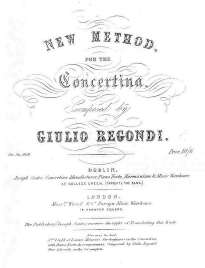
E52
———.
Rudimenti del Concertinista, Or a Complete Series of Elementary and
Progressive Exercises for the Concertina.
London: Joseph Scates, 1844; later by Wheatstone & Co.
CSFRI
This publication (which is in English except for the
title) dates from shortly after Joseph Scates (formerly a Wheatstone
employee) set up shop as a London publisher and concertina
maker. In 1850-1851, Scates sold his concertina manufacturing
business to George Case and moved to Dublin, where he was
a publisher and music retailer. See Wayne, Concertina Book,
52-55; and Parkinson, Victorian Music Publishers, 245.
E53
Rothstein, A. von.
Neue praktische englische Concertina Schule.
Russia (city and publisher unknown), c. 1890-1900 (in German and Russian).
OSS
The English translation is New Practical English Concertina
School. “Another fine concertina tutor was published in the late
1800s, not in England but in Russia. Written by A. von Rothstein,
one of the great Russian virtuosi, it was intended to be a
guide for secondary school pupils. In Russia, every secondary
school student was required to learn concertina. There were
many virtuosi, who performed Bach, Vivaldi, Mozart, and other
strictly classical music, in a monophonic style. Their arrangements
were much more conservative than the arrangements popular in
England”; see Richard
Carlin, “Concertina Tutors: A Brief Survey,”
Free Reed 24 (July 1976): 4-5, drawing upon information
provided by Boris Matusewitch (see
E38).
E54
Roylance, Charles George.
The English Concertina Player’s Companion.
London: C. Roylance, 1886.
BL
Roylance (c. 1840–?) was a musical instrument dealer, concertina
performer-teacher, and author-publisher of tutors for English and
Anglo concertina and other instruments. Most banjos and
concertinas marketed under his name were made by other firms.
He sponsored at least one contest—Mr. C. Roylance’s English
Concertina Contest, Cambridge Hall, Oxford Street (July 5, 1870).
E55
———.
Harmonized Scales and Studies for the English Concertina.
London: C. Roylance, 1877.
HM
E56
———.
How to Learn the English Concertina Without a Master.
London: C. Roylance, 1877.
BL, HM
Roylance dismissed the difficulties of learning to
play: “The fingering of the Concertina is extremely easy, so with ordinary
attention to the following instructions, any person with
the least musical talent, may in a very short time perform any
favorite melody” (p. 2). He offered his own undocumented history
of the instrument: “The English Concertina was invented
by Professor Charles Wheatstone . . . and was introduced to
Public notice in June 1838. The first instrument was sold to Capt.
Gardner of the 2nd Life Guards, it was then called the “Symphonian” [sic]
with bellows, and not until December 27th of that
year, was it named the Concertina” (p. 2).
E57
———.
Roylance’s Complete English Concertina School . . . Together with Full
Instructions for Learning the Bass Concertina.
London: C. Roylance, c. 1875 and 1880 (Enlarged edition).
HM
E58
———.
Studies for the English Concertina.
London: C. Roylance, c. 1880.
ADVERT
E59
Russell, Joseph.
Russell’s New and Improved Self-Instructor for the English Concertina.
London: J. Russell, 1854.
BL
E60
The Salvation Army Anglo-German and English Concertina Tutor.
London: [Salvation Army] Publishing Offices, 1905.
BL
One of two tutors written for both Anglo and English
concertina (= A73;
see also E32).
The Salvation Army, founded by William Booth
in 1865, became a strong market for concertinas.
The first Salvation Army concertina band was formed in Bristol Citadel in
1884; others soon followed. Even earlier, George Jones
(see A39) was making
concertinas to Salvation Army specifications
(see A65).
On the Salvation Army concertina bands, see Major Archie Burgess,
“100 Years of Concertinas,” The War Cry
(October 8, 1932); reprinted in Concertina Magazine
24 ((1988): 12-13; Nigel Pickles, “Concertina Bands,” Concertina
Magazine 7 (Summer 1984): 10; and
Wayne, Concertina Book, 60.
The Bristol Citadel Salvation Army Concertina Band,
originally having about thirty members, was reduced to
four members by the time it disbanded in 1971; see Mr. and Mrs.
Baker, “Bristol Citadel Concertina Band,” Free Reed
12 (May 1973), 8-9.
E61
The Salvation Army Concertina Tutor.
London: [Salvation Army] Publishing Department, 1891; 2nd ed., 1892.
ADVERT
E62
The Salvation Army Tutor for the English Concertina.
London: Salvationist Publishing and Supplies, 1924 (ADVERT);
new ed.: rev. and enlarged, 1935 (HM, BL, LC)
and 1945 (ADVERT).
The tutor supposedly was written by Lt. Col. Bristow.
E63
Sedgwick, Alfred B.
Sedgwick’s Complete System of Instruction for the Concertina.
London: Levesque, Edmeades & Co., 1854.
BL, CSFRI
Sedgwick (birth and death dates unknown) was one of the
first music-hall concertinists and a member of the
Blagrove-Case-Regondi-Sedgwick concertina quartet, founded in 1844.
In 1850-1851, he emigrated from England to New York and
became a well-known composer for the musical stage. He also
performed, often with son Charles (b. 1848-?) on baritone or
bass concertina, in major theaters in New York. See Michael Meckna, ed.,
The Collected Works of Alfred B. Sedgwick,
Nineteenth Century American Musical Theater, 7 (New York: Garland, 1994);
and Atlas, The Wheatstone English
Concertina, 52, 57, and 67. In his Complete System, he extolled
the virtues of the concertina, while revealing Victorian
attitudes towards women: “There is no instrument as yet invented
that presents so many advantages to the Amateur, as the
Concertina . . . one of those destined to continue alike popular
in the Concert or Drawing room . . . To ladies it is particularly
recommended for its extreme elegance and portability, as also on
account of its being the only wind instrument at their
command.” (p. 1).
E64
———.
Sedgwick’s Hand-book for the English Concertina.
London: H. Darewski, c. 1875; London: Charles Sheard & Co., c. 1890.
HM
E65
———.
Sedgwick’s New Method for the English Concertina.
New York: S.T. Gordon, 1870.
LC
E66
Seymour, W.
Dallas’ Tutor for the English Concertina.
London: John E. Dallas & Sons, c. 1920.
HM
The tutor was published during the period 1915-1934,
when Dallas & Sons was located at 202 High Holborn.
E67
Simpson, John.
Easy Method for Learning the Concertina.
London: Simpson & Co., c. 1855.
BL
Simpson—a flute and flageolet maker—also made concertinas
(Wayne, Concertina Book, 72) and edited
Simpson’s Concertina Journal in the 1850s and 1860s.
E68
Warren, Joseph.
Robert Cocks & Co.’s Hand Book of Instructions for the English Concertina
with Forty Four Favourite Airs.
London: Robert Cocks & Co., 1855.
BL
Warren (1804-1881) was an organist, music historian and
collector of original manuscripts of the great composers, and
composer-arranger of a large collection of classical music
for both the English and Anglo concertina. He also arranged opera
excerpts for Charles Wheatstone’s mouth-blown symphonium,
from which the English concertina is a direct offspring; see
Atlas, The Wheatstone English Concertina,
Chapters 5-6; and New Grove/2 27, 93-94.
E69
———.
Warren’s Instructions for the Concertina.
London: Wheatstone & Co., c. 1844
(and eight subsequent editions through 1905).
BL, CSFRI, HM, AVAIL
It is widely known as Complete Instructions for the Concertina;
the title shown on the title page and as advertised in
Wheatstone & Co., “Music for the Concertina,” 1848.
The ninth edition is available in reprint (Bristol: Jenny Cox, 1998);
for a review, see Atlas, “Concertinas 1998-1999:
A (Brief) Review-Essay,” The Free-Reed Journal 2 (2000): 41-42.
E70
Watson, Roger.
Handbook for English Concertina.
London: Wise Publications, 1981.
AVAIL
The hype on the cover outdoes even the Victorians:
“The First complete guide to playing the English Concertina . . . [N]o
satisfactory tutor for this instrument has ever been published.
This clearly written method fills the gap at last . . . ” A
different perspective is provided in Suzette Watkins’s
review in Concertina Magazine 1 (Winter 1982): 20.
E71
Wheatstone’s Instructions for the English Concertina, rev. ed.
London: Wheatstone & Co., 1946.
HM
Added subsequent to original publication:
E72
Branchett, Les.
Conquering the Concertina: A Comprehensive Guide to the English Concertina.
Gloucester: Sherborne House Publications, 2002.
AVAIL
E73
De Snoo, Pauline.
Concertina Course, Volume One.
Schijndel (NL): De Snoo, 2002.
AVAIL
Contains a "Technical Appendix" by Dave Elliott and a CD; in English with Dutch translation
forthcoming; vol. 2 is also forthcoming.
The website is
http://www.concertina.nl.
The tutor can be ordered through
jdesnoo@ncrvnet.nl.
E74
Miles, Dick.
The Concise English Concertina: A Tutor.
Cork: Milestone Publications, 2002.
AVAIL
E75
Atlas, Allan.
Contemplating the Concertina: An Historically-Informed Tutor for the English
Concertina.
Amherst, MA: The Button Box, Inc., 2003.
AVAIL (at http://www.buttonbox.com)
In-depth coverage of playing
techniques, with exercises and musical excerpts (as well as some complete
pieces) for the English concertina, drawing on the author’s early study with Boris Matusewitch
(see E38)
and subsequent playing experience. The tutor also contains exercises (with extensive
commentary) from the tutors of
Alsepti ( E1),
Regondi ( E51), and
other master performer-teachers from the Victorian era, as well as extensive
historical background about the development of playing techniques. Of special
note is the section on the use of bellows, surely the most thorough discussion
of the topic to date.
E76
De Snoo, Pauline.
Concertina Course, Volume One: Play-Along Supplement.
Schijndel (NL): De Snoo, 2003 (CD included).
AVAIL (at http://www.concertina.nl)
The Concertina Course, Volume One
( E73)
has been complemented by an additional book and play-along CD (which also can be used
separately
from E73).
For some tunes in the book, piano scores
also are included for use in at-home piano accompaniment. The CD contains two renditions of
each play-along tune: (1) a concertina-piano track and (2) a piano-only track for
pure accompaniment.
E77
Though primarily designed for the “Jackie” student model,
the tutor can be used with any model of English concertina.
Sound files for all tunes in the tutor are provided at
www.concertinaconnection.com,
which also contains information
on the “Jackie” and other concertinas from The Concertina Connection.
E78
The Concertina Without a Master: Containing the Elements of Music and
Complete Instruction for the English Concertina.
New York: C. H. Ditson & Co., 1857.
OSS
E79
Miles, Dick.
Song Accompaniment for English Concertina.
Cork: Milestone Publications, 2004.
AVAIL
A follow-up to The Concise English Concertina
( E74),
going into further depth on song accompaniment. It contains
examples of songs in different styles and information on harmony,
chord substitution, etc.
E80
Minasi, Carlo.
A Concise Method for the Study of the Concertina,
Comprising the Rudiments of Music, Progressive Scales, Exercises,
and Selections from the Most Approved Masters.
Place and publisher unknown; c. 1860.
OSS
Probably a modified version of Minasi’s Instructions for the Concertina
( E42).
E81
———.
Hopwood and Crew’s English Concertina Tutor Without a Master.
London: Hopwood & Crew, c. 1900.
OSS
E82
Berbiguier, Benoit Tranquille.
Exercises for Acquiring Equality of Fingering and Firmness of Tone.
London: Wheatstone, c. 1900.
OSS
Berbiguier (1782–1838), a French-born flutist, was among the best-known
composers for the flute in the early eighteenth century. Some of his flute
exercises, like those of Louis-François-Phillippe Drouëtt
(see E23 ),
are highly amenable to cross-over use as exercises for the English concertina.
It is thought that the exercises for concertina were based on 18 Exercises or Etudes for Flute,
(Revised and Edited by Georges Barrère; New York: G. Schirmer, 1925), which were based on
exercises from Berbiguier’s tutors, Nouvelle Méthode pour la Flute
(Paris: Janet et Cottelle, c. 1818); and Methode Complète de Flûte (Paris: Alphonse Ledec, 1818).
In particular, the exercises for concertina were not an adaptation of
Exercises on Tempered or Altered Notes … Composed for the Flute (London: Wheatstone, 1827).
These exercises, though published by Wheatstone during Berbiguier’s lifetime, are advanced
flute-specific exercises, inadaptable to the concertina. In 1848, Berbiguier compositions
for concertina (not including the Exercises) were listed in
Music for the Concertina Published by Messrs. Wheatstone & Co. These
included Duet in C (from Op.7) and Duet in F (from Op. 45) for flute and concertina
or two concertinas and Theme (Op. 49) for concertina and pianoforte. A few other
Berbiguier pieces, ostensibly for concertina, were later advertised by
Wheatstone and other publishers. At the time of Berbiguier’s death (20 January 1838),
English concertina playing was truly in its infancy. Berbiguier possibly never knew
that compositions and exercises for the concertina would be attributed to him.
E83
Pietra, Guiseppe T. (pseud.)
The National Tutor for the English Concertina.
London, c. 1890.
OSS
The author’s real name was Joseph T. Stone
(see E47),
a prolific arranger of music for pianoforte.
Have feedback on this article?
Send it to the author.
Reprinted from the Concertina Library
http://www.concertina.com
© Copyright 2000– by Randall C. Merris
|

Signor Alsepti's Tutor
for English Concertina
Lachenal, c. 1895
Contents
The original version of this article appeared in The Free-Reed Journal, Vol. 4 (2002), pp. 85-118.
© 2002 Randall C. Merris.
Links to related documents
-
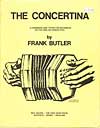 The Concertina: A Handbook and Tutor for Beginners on the English Concertina
The Concertina: A Handbook and Tutor for Beginners on the English Concertina
-
by Frank E. Butler
- The standard tutor for the English concertina during
the concertina revival in the 1970s. Based on classes offered at the Battersea
Institute under the auspices of the Inner London Education Authority. Introduction
to music, exercises, and elementary tunes.
Originally published by Neil Wayne at the Free Reed Press,
Duffield, Derby, England, in 1974. 64pp plus covers. The scan was made by
Wes Williams.
-
Posted 15 January 2005
-
» read full document in pdf
-
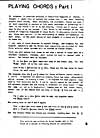 Playing Chords [for English, Anglo, and Maccann Duet]
Playing Chords [for English, Anglo, and Maccann Duet]
-
by Brian Hayden
-
"I would like to explain the system that I use when teaching
players about chords, their structure, and placement. Chords are
what I am most requested to explain at folk music workshops or
gatherings as I tend to use chords a lot in my own playing." (From
the introduction.)
Includes a novel notation for chords which is used elsewhere on this website.
As published in Concertina Magazine
(Australia) in three parts, 12-14 (1985), 12:5-7,
13:12-14, and 14:8-10; with corrections in 15-16 (1986), 15:14
and 16:1,6,9.
-
Posted 01 March 2004
-
» read full article in pdf
|




